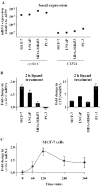Regulation of the human cyclin C gene via multiple vitamin D3-responsive regions in its promoter
- PMID: 15863722
- PMCID: PMC1087898
- DOI: 10.1093/nar/gki502
Regulation of the human cyclin C gene via multiple vitamin D3-responsive regions in its promoter
Abstract
The candidate human tumor suppressor gene cyclin C is a primary target of the anti-proliferative hormone 1alpha,25-dihydroxyvitamin D3 [1alpha,25(OH)2D3], but binding sites for the 1alpha,25(OH)2D3 receptor (VDR), so-called 1alpha,25(OH)2D3 response elements (VDREs), have not yet been identified in the promoter of this gene. We screened various cancer cell lines by quantitative PCR and found that the 1alpha,25(OH)2D3 inducibility of cyclin C mRNA expression, in relationship with the 24-hydroxylase (CYP24) gene, was best in MCF-7 human breast cancer cells. To characterize the molecular mechanisms, we analyzed 8.4 kb of the cyclin C promoter by using chromatin immunoprecipitation assays (ChIP) with antibodies against acetylated histone 4, VDR and its partner receptor, retinoid X receptor (RXR). The histone 4 acetylation status of all 23 investigated regions of the cyclin C promoter did not change significantly in response to 1alpha,25(OH)2D3, but four independent promoter regions showed a consistent, 1alpha,25(OH)2D3-dependent association with VDR and RXR over a time period of 240 min. Combined in silico/in vitro screening identified in each of these promoter regions a VDRE and reporter gene assays confirmed their functionality. Moreover, re-ChIP assays monitored simultaneous association of VDR with RXR, coactivator, mediator and RNA polymerase II proteins on these regions. Since cyclin C protein is associated with those mediator complexes that display transcriptional repressive properties, this study contributes to the understanding of the downregulation of a number of secondary 1alpha,25(OH)2D3-responding genes.
Figures






References
-
- Sutton A.L., MacDonald P.N. Vitamin D: more than a ‘bone-a-fide’ hormone. Mol. Endocrinol. 2003;17:777–791. - PubMed
-
- Mørk Hansen C., Binderup L., Hamberg K.J., Carlberg C. Vitamin D and cancer: effects of 1,25(OH)2D3 and its analogs on growth control and tumorigenesis. Front. Biosci. 2001;6:D820–D848. - PubMed
-
- Lemay J., Demers C., Hendy G.N., Delvin E.E., Gascon-Barre M. Expression of the 1,25-dihydroxyvitamin D3-24-hydroxylase gene in rat intestine: response to calcium, vitamin D3 and calcitriol administration in vivo. J. Bone Miner. Res. 1995;10:1148–1157. - PubMed
-
- Swami S., Raghavachari N., Muller U.R., Bao Y.P., Feldman D. Vitamin D growth inhibition of breast cancer cells: gene expression patterns assessed by cDNA microarray. Breast Cancer Res. Treat. 2003;80:49–62. - PubMed
-
- Palmer H.G., Sanchez-Carbayo M., Ordonez-Moran P., Larriba M.J., Cordon-Cardo C., Munoz A. Genetic signatures of differentiation induced by 1α,25-dihydroxyvitamin D3 in human colon cancer cells. Cancer Res. 2003;63:7799–7806. - PubMed

